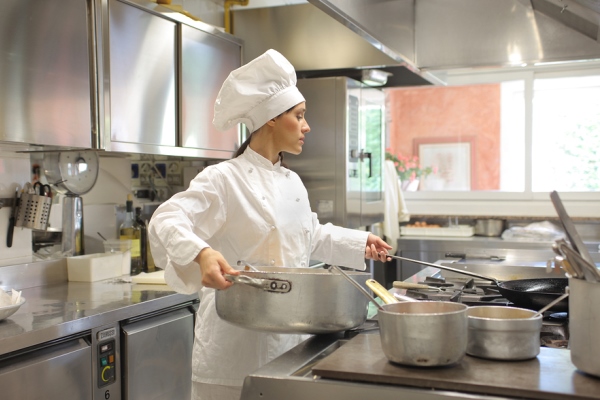Food Service Safety

"Would you like fries with that?" is one important question when you work in a restaurant. Another is, "What are the hazards of my job?" Actually, that’s a two-part question because you also need to ask, "And how can I keep from getting injured?"
Some of the common hazards in restaurant work are these:
- Falls from slipping on wet, greasy floors and tripping over clutter.
- Collisions at two-way doors connecting kitchens and dining areas.
- Burns from steam, hot oil, food and surfaces.
- Back injuries from lifting cartons of food out of the freezer and trays of cups from the dishwasher.
- Heat illness from hot, humid working conditions.
- Repetitive strain injuries from tasks such as building sandwiches or lifting fry baskets.
- Skin inflammations on the hands and arms from continued exposure to detergents and water.
- Electrical shock from faulty equipment or contact with moisture.
- Kitchen fires fueled by excess grease and paper trash.
Those are some of the things that can go wrong in a food industry workplace. What can you do to make things go right?
- Get safety training for your job. Ask your supervisor to arrange this training promptly.
- Ask questions if you don’t understand something or if you encounter a new situation.
- Dress for your job with safety in mind.
- Choose low-heeled, secure shoes with a non-skid sole and an enclosed toe. A falling coffee cup can inflict as much damage on your toes as a falling hammer if it lands the wrong way.
- Dress in light, layered clothing to allow for hot kitchen conditions or cooler dining areas.
- Talk to your supervisor about fire-resistant fabrics for kitchen work.
- Drink water frequently to prevent heat illness. Take your breaks in a cool place.
- Follow the designated traffic patterns to avoid collisions with other workers, especially at doorways and around stoves and fryers.
- Keep kitchen cutting tools sharp and in good condition.
- Keep your mind on your work to prevent cuts and puncture wounds.
- Do not reach across steam tables, fryers, stoves and other hot surfaces and materials.
- Protect your hands from contact with detergents, cleansers and water by using gloves. Dry your hands and replenish the skin’s natural oils by frequently applying moisturizers.
- When lifting, avoid twisting or bending your back. Get help with heavy loads. To reduce lifting, consider rearranging the work area so supplies are at the right level.
- If you perform repeated tasks such as slicing food or running the cash register, be aware of developing pain or numbness in your hands, wrists and arms because these can be the first signs of repetitive strain injuries. Try to vary your movements and keep your wrists at a relaxed, natural angle. Don’t hunch over your work, even if you are creating a dessert masterpiece.
Much of your restaurant training has to do with keeping the customer happy and safe. You are just as important, so learn how to protect yourself on the job.
